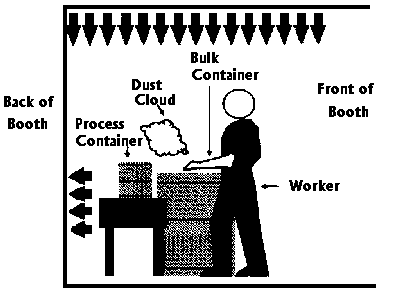Control of Dust From Powder Dye Handling Operations
1997
DHHS (NIOSH) Publication Number 97-107
Hazard
The manual transfer of powder dyes from bulk containers to smaller process containers generates significant amounts of dust. Worker exposure to dye dust through breathing or skin contact can result in adverse health effects such as occupational asthma, eczema, and severe allergic reactions. In addition, the National Institute for Occupational Safety and Health (NIOSH*) recognizes certain dyes as potential occupational carcinogens. Therefore, NIOSH recommends limiting dye dust exposures to the lowest feasible concentrations to prevent these health problems.
Controls
Workers in powder dye handling operations are often poorly protected from dust exposures. NIOSH research has shown that worker exposures to dye dust can be effectively reduced by as much as 70% with the following combination of controls: adequate ventilation, redesigned bulk containers, and appropriate work practices.
Ventilation
- Semi Downdraft ventilation booths are recommended for use during the manual transfer of dyes. A vertical air shower pushes airborne dust out of the worker’s breathing zone, until the dust is captured and exhausted from the work area (see ILLUSTRATION). Without the air shower, eddy currents can from around the worker and stir up dust. All tasks associated with the manual transfer of powdered dyes (weighing, scooping, etc.) should be performed inside the booth under the air shower.
Bulk Containers
- Most powder dyes are shipped in drums that range in height from 30 to 36 inches. When manually transferring dye from these drums, many workers must lean forward and place their heads inside the drum to scoop out dye near the bottom. In this position, the worker is greatly exposed to airborne dye dust, even in a ventilated booth. Shorter drums should be used to eliminate the need for workers to place their heads inside the drum. Maintaining a space between the worker’s face and the top of the drum enables the booth ventilation to capture the dust before it reaches the worker’s breathing zone. Limiting the drum height to 25 inches significantly reduces worker dust exposures.
Work Practices
- Workers should use slow, smooth movements when handling dye to keep dust concentrations low. Dye transport distances between the bulk and process containers should be kept to a minimum. The height at which the dye is dropped into a container should also be kept to a minimum. Workers should avoid skin contact with the dyes by using protective clothing such as gloves, long-sleeved shirts, and aprons.
*NIOSH is the Federal Agency responsible for conducting research and making recommendations for preventing work related illness and injuries. HAZARD CONTROLS are based on research studies that show how worker exposure to hazardous agents or activities can be significantly reduced.
Illustration: A Semi Downdraft Ventilated Booth

Filtered air enters born the ceiling of the booth, collects dust as it flows past the worker, and exhausts out the back of the booth through grates (SIDE VIEW).
Acknowledgments
The principal contributors to this HAZARD CONTROLS are Marjorie E. Wallace, Division of Physical Sciences and Engineering, and Jerome P. Flesch, Education and Information Division, NIOSH. Support for this study was provided by the Ecological & Toxicological Association of Dyes & Organic Pigments Manufacturers (ETAD), Washington, D.C.
This document is in the public domain and may be freely copied or reprinted. NIOSH encourages all readers of this HAZARD CONTROLS to make it available to all interested employers and workers.
